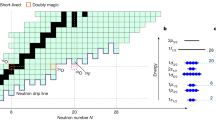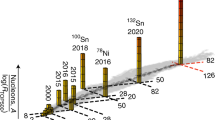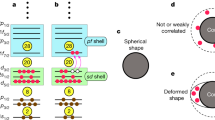Abstract
Atomic nuclei have a shell structure1 in which nuclei with ‘magic numbers’ of neutrons and protons are analogous to the noble gases in atomic physics. Only ten nuclei with the standard magic numbers of both neutrons and protons have so far been observed. The nuclear shell model is founded on the precept that neutrons and protons can move as independent particles in orbitals with discrete quantum numbers, subject to a mean field generated by all the other nucleons. Knowledge of the properties of single-particle states outside nuclear shell closures in exotic nuclei is important2,3,4,5 for a fundamental understanding of nuclear structure and nucleosynthesis (for example the r-process, which is responsible for the production of about half of the heavy elements). However, as a result of their short lifetimes, there is a paucity of knowledge about the nature of single-particle states outside exotic doubly magic nuclei. Here we measure the single-particle character of the levels in 133Sn that lie outside the double shell closure present at the short-lived nucleus 132Sn. We use an inverse kinematics technique that involves the transfer of a single nucleon to the nucleus. The purity of the measured single-particle states clearly illustrates the magic nature of 132Sn.
This is a preview of subscription content, access via your institution
Access options
Subscribe to this journal
Receive 51 print issues and online access
$199.00 per year
only $3.90 per issue
Buy this article
- Purchase on Springer Link
- Instant access to full article PDF
Prices may be subject to local taxes which are calculated during checkout



Similar content being viewed by others
References
Mayer, M. G. & Jensen, J. H. D. Theory of Nuclear Shell Structure (Wiley, 1955)
Barbieri, C. & Hjorth-Jensen, M. Quasiparticle and quasihole states of nuclei around 56Ni. Phys. Rev. C 79, 064313 (2009)
Kartamyshev, M. P., Engeland, T., Hjorth-Jensen, M. & Osnes, E. Effective Interactions and shell model studies of heavy tin isotopes. Phys. Rev. C 76, 024313 (2007)
Sarkar, S. & Sarkar, M. S. Shell model study of neutron-rich nuclei near 132Sn. Phys. Rev. C 64, 014312 (2001)
Grawe, H., Langanke, K. & Martínez-Pinedo, G. Nuclear structure and astrophysics. Rep. Prog. Phys. 70, 1525–1582 (2007)
Cowan, J. J., Thielemann, F.-K. & Truran, J. W. The r-process and nucleochronology. Phys. Rep. 208, 267–394 (1991)
Coraggio, L., Covello, A., Gargano, A. & Itaco, N. Similarity of nuclear structure in the 132Sn and 208Pb regions: proton–neutron multiplets. Phys. Rev. C 80, 021305(R) (2009)
Terasaki, J., Engel, J., Nazarewicz, W. & Stoitsov, M. Anomalous behavior of 2+ excitations around 132Sn. Phys. Rev. C 66, 054313 (2002)
Hoff, P. et al. Single-neutron states in 133Sn. Phys. Rev. Lett. 77, 1020–1023 (1996)
Urban, W. et al. Neutron single-particle energies in the 132Sn region. Eur. Phys. J. A 5, 239–241 (1999)
Kozub, R. L. et al. Neutron single particle strengths from the (d,p) reaction on 18F. Phys. Rev. C 73, 044307 (2006)
Thomas, J. S. et al. Single-neutron excitations in neutron-rich 83Ge and 85Se. Phys. Rev. C 76, 044302 (2007)
Rehm, K. E. et al. Study of the 56Ni(d,p)57Ni reaction and the astrophysical 56Ni(p,γ)57Cu reaction rate. Phys. Rev. Lett. 80, 676–679 (1998)
Stracener, D. W. Status of radioactive ion beams at the HRIBF. Nucl. Instrum. Methods A 521, 126–135 (2004)
Pain, S. D. et al. Development of a high solid-angle silicon detector array for measurement of transfer reactions in inverse kinematics. Nucl. Instrum. Methods B 261, 1122–1125 (2007)
Wiza, J. L. Microchannel plate detectors. Nucl. Instrum. Methods 162, 587–601 (1979)
Thompson, I. J. Coupled reaction channels calculations in nuclear physics. Comput. Phys. Rep. 7, 167–211 (1988)
Reid, R. V. Local phenomenological nucleon–nucleon potentials. Ann. Phys. 50, 411–448 (1968)
Strömich, A. et al. (d,p) reactions on 124Sn, 130Te, 138Ba, 140Ce, 142Nd, and 208Pb below and near the Coulomb barrier. Phys. Rev. C 16, 2193–2207 (1977)
Pang, D. Y., Nunes, F. M. & Mukhamedzhanov, A. M. Are spectroscopic factors from transfer reactions consistent with asymptotic normalization coefficients? Phys. Rev. C 75, 024601 (2007)
Kramer, G. J., Blok, H. P. & Lapikás, L. A consistent analysis of (e,e′p) and (d,3He) experiments. Nucl. Phys. A 679, 267–286 (2001)
Ellegaard, C., Kantele, J. & Vedelsby, P. Particle–vibration coupling in 209Pb. Nucl. Phys. A 129, 113–128 (1969)
Hirota, K., Aoki, Y., Okumura, N. & Tagishi, Y. Deuteron elastic scattering and (d,p) reactions on 208Pb at E d = 22 MeV and j-dependence of T 20 in (d,p) reaction. Nucl. Phys. A 628, 547–579 (1998)
Acknowledgements
This work was supported by the US Department of Energy under contract numbers DEFG02-96ER40995 (Tennessee Technological University (TTU)), DE-FG52-03NA00143 (Rutgers, Oak Ridge Associated Universities), DE-AC05-00OR22725 (Oak Ridge National Laboratory), DE-FG02-96ER40990 (TTU), DE-FG03-93ER40789 (Colorado School of Mines), DE-FG02-96ER40983 (University of Tennessee, Knoxville), DE-FG52-08NA28552 (Michigan State University (MSU)), DE-AC02-06CH11357 (MSU), the National Science Foundation under contract numbers NSF-PHY0354870 and NSF-PHY0757678 (Rutgers) and NSF-PHY-0555893 (MSU), and the UK Science and Technology Funding Council under contract number PP/F000715/1.
Author information
Authors and Affiliations
Contributions
K.L.J., D.W.B., J.C.B., J.A.C., R.L.K., J.F.L., C.D.N., S.D.P., D.S., M.S.S. and J.S.T. designed the experiment and developed the experimental tools and techniques. K.L.J., D.W.B., J.C.B., K.Y.C., R.H., R.L.K., J.F.L., B.H.M., S.D.P. and D.S. set up the experimental equipment, including new, unique detectors and associated electronics. K.L.J., D.W.B., J.C.B., K.Y.C., R.L.K., B.H.M., S.D.P., T.P.S. and J.S.T. developed online and offline analysis software routines and algorithms. K.L.J., A.S.A., D.W.B., J.C.B., K.Y.C., K.A.C., L.E., C.H., R.H., R.K., R.L.K., J.F.L., R.L., Z.M., B.H.M., C.D.N., S.D.P., N.P.P., D.S., J.F.S., M.S.S., T.P.S. and J.S.T. while running the experiment, assessed the quality and performed preliminary analyses of online data. K.L.J., K.Y.C., R.K., R.L.K., B.H.M., S.D.P. and T.P.S. analysed the data and calibrations. K.L.J., D.W.B., J.A.C., R.L.K., F.M.N. and S.D.P. interpreted the data, including theoretical calculations. K.L.J., J.A.C. and F.M.N. wrote the manuscript. K.L.J., D.W.B., J.C.B, K.A.C., J.A.C., R.L.K., J.F.L., F.M.N., S.D.P., J.F.S., M.S.S. and J.S.T. revised the manuscript.
Corresponding author
Ethics declarations
Competing interests
The authors declare no competing financial interests.
Supplementary information
Supplementary information
This file contains Supplementary Data, Supplementary Figures 4-5 with legends, Supplementary Tables 2-5 and References. (PDF 280 kb)
Rights and permissions
About this article
Cite this article
Jones, K., Adekola, A., Bardayan, D. et al. The magic nature of 132Sn explored through the single-particle states of 133Sn. Nature 465, 454–457 (2010). https://doi.org/10.1038/nature09048
Received:
Accepted:
Issue Date:
DOI: https://doi.org/10.1038/nature09048
This article is cited by
-
First observation of 28O
Nature (2023)
-
Gamma-ray spectroscopy of fission fragments with state-of-the-art techniques
La Rivista del Nuovo Cimento (2022)
-
Nuclear moments of indium isotopes reveal abrupt change at magic number 82
Nature (2022)
-
Mass measurements of 99–101In challenge ab initio nuclear theory of the nuclide 100Sn
Nature Physics (2021)
-
Experimental study of intruder components in light neutron-rich nuclei via single-nucleon transfer reaction
Nuclear Science and Techniques (2020)
Comments
By submitting a comment you agree to abide by our Terms and Community Guidelines. If you find something abusive or that does not comply with our terms or guidelines please flag it as inappropriate.



